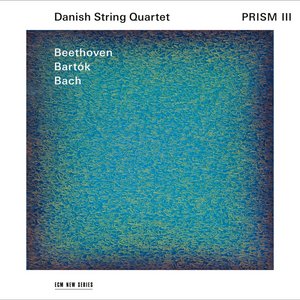New York, NY (Top40 Charts) This is the third volume of the Danish String Quartet's ongoing Prism series, which shows how the radiance of Bach's fugues is refracted through Beethoven's quartets to illuminate the work of later composers. "Beethoven had taken a fundamentally linear development from Bach," the Danes note, "and exploded everything into myriads of different colours, directions and opportunities - much in the same way as a prism splits a beam of light." Here the quartet follow the beam from Johann
Sebastian Bach's Fugue in C-sharp minor (The Well-Tempered Clavier, Book I) through Ludwig van Beethoven's String Quartet No. 14, to B�la Bart�k's String Quartet No. 1.
"Inevitably, we base our work on what we know, as individuals and as a group, but the important thing to us as musicians is that these connections be experienced widely on an intuitive level. We hope the listener will join us in the wonder of these beams of music that travel all the way from Bach through Beethoven as far as to our own times."
Danish String Quartet violist Asbj�rn N�rgaard elaborated on the origins of the Prism project in an interview with The
Boston Globe: "The idea came when I was reading Lewis Lockwood's book about Beethoven. [Beethoven: The
Music and the Life] He writes about Beethoven's lifelong obsession with Bach and, in particular, The Well-Tempered Clavier. In his last years, Beethoven basically spent all his time studying Bach and writing string quartets. Most of the musical material that he used to craft his last five string quartets can be more or less directly found in specific fugues by Bach."
In the liner notes for Prism III, Paul Griffiths traces the ways in which the essence of Bach's c-sharp minor fugue is transformed in Beethoven's Op. 131.
In turn, Bart�k's First String Quartet, completed in 1909, when the composer was just 27, and still in the process of discovering his own artistic voice, paid direct homage to Beethoven's String Quartet No. 14. The first movement begins in the same spirit as Beethoven's quartet, and as Bart�k biographer
David Cooper has suggested, "one might argue that there is an even more direct correspondence between Bart�k's overlapping entries and his pairing of instruments and the approach taken by Beethoven in the fourth movement of Op. 131."
The Danish String Quartet has the unusual distinction of being a group of young musicians with an extensive - almost lifelong - history of musical collaboration. Its three Danish-born members, Rune Tonsgaard S�rensen,
Frederik �land and Asbj�rn N�rgaard first played chamber music together in a music summer camp before they were even teenagers, and then continued to do so throughout their school years. "All of a sudden, at the ages of 15 and 16, we were a serious string quartet. It all happened so fast that none of us seemed to notice the transition. We were enrolled at The Royal Academy of
Music and our life as music students had begun. None of us have any memory of our lives without the string quartet."
In 2006 they made their first recordings as the Young Danish String Quartet, immediately attracting the attention of publications from Gramophone to The New York Times. In 2008, Norwegian cellist Fredrik Sch�yen Sj�lin joined the quartet, and the group has since gone from strength to strength, with repertoire embracing core classical and contemporary music, as well as folk music, which they also play with verve and commitment - as their album Last Leaf (released in 2017) confirms.
The Danish String Quartet made its first ECM recording in 2015, playing
Thomas Ad�s's Arcadiana, Per N�rg�rd's Quartetto Breve, and Hans Abrahamsen's 10 Preludes.
The DSQ's Prism series was initiated in 2018 with the first volume incorporating Bach's Fugue in E-flat major from The Well-Tempered Clavier, Beethoven's String Quartet No. 12 and Shostakovich's Quartet No. 15. "The whole approach invites active, committed listening," wrote Fiona Maddocks in The Observer. Prism I also received a Grammy nomination.
Prism II features Bach's B-flat minor Fugue from The Well-Tempered Clavier, Beethoven's String Quartet Op. 130/"Gro�e Fuge" Op. 133, and Alfred Schnittke's Quartet No. 3. ("A revelatory connected soundscape in which Beethoven's introspection feels more unsettling than usual." - BBC
Music Magazine.)
Prism III was recorded in Reitstadl Neumarkt in November 2017 and produced by Manfred Eicher.
CD booklet includes liner notes by Paul Griffiths and a performers' note by the Danish String Quartet.





















